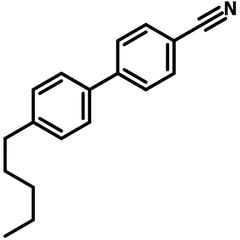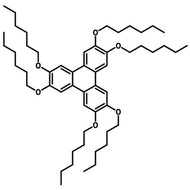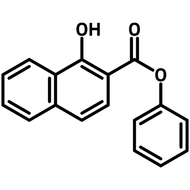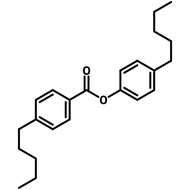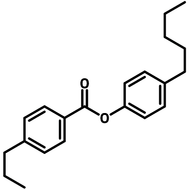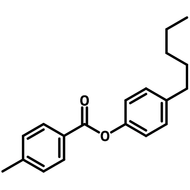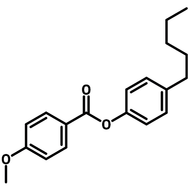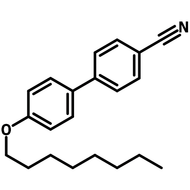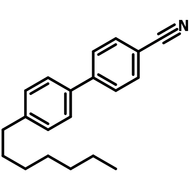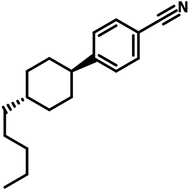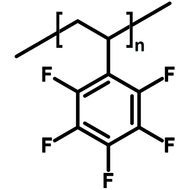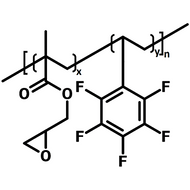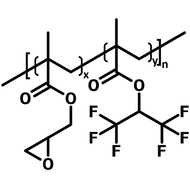4′-Pentyl-4-biphenylcarbonitrile (8OCB), room temperature liquid crystal (nematic)
Liquid crystal for the application of optical electronics i.e. in liquid-crystal display (LCD)
4′-Pentyl-4-biphenylcarbonitrile (5CB), CAS number 40817-08-1, is a nematic liquid crystal at room temperature with a chemical structure of cyano and pentyl substituted 1,1'-biphenyl at 4,4'-positions. 5CB undergoes a phase transition from a crystalline state to a nematic state at 22.5 °C and it goes from a nematic to an isotropic state at 35.0 °C.
In a binary 5CB/7CB mixture, crystal to nematic transition only is observed at lower rates but no apparent phase transition at higher rates, This gives a indication of a favourable synergism in the binary mixture compared to the pure system. Nematic to crystalline transition, however, is not observed in the binary mixture with increased disorder due to the different chain lengths presented in the liquid crystal phase.
When ZnO NPs is presented in 5CB as an additive, not only the threshold voltage but also the driving voltage (Vd) of 5CB can be dramatically decreased. The decrease of driving voltage of liquid crystal can help reduce power consumption for liquid crystal displays.
Room temperature nematic liquid crystal
Mesomorphic range 18.0 to 35.0 °C
Reduced power consumption for liquid crystal displays
Decreases threshold voltage and driving voltage with ZnO
Worldwide shipping
Quick and reliable shipping
High purity
>98% High purity
Chemical Structure

General Information
| CAS Number | 40817-08-1 |
| Chemical Formula | C18H19N |
| Molecular Weight | 249.36 |
| Full Name | 4′-Pentyl-4-biphenylcarbonitrile |
| Synonyms | 5CB, 4-Cyano-4'-pentylbiphenyl, 4-Pentyl-4-cyanobiphenyl |
| Classification / Family | Biphenylcarbonitrile, Room Temperature Liquid Crystals |
Product Details
| Purity | >98% (1HNMR) |
| Form | White liquid |
| Refractive Index | n20/D 1.532 (lit.) |
| Mesomorphic Range | 18.0 to 35.0 °C (lit.) |
| Density | 1.008 g/mL at 25 °C (lit.) |
| Boiling Point | 215 °C/3.0 mmHg |
MSDS Documentation
 4′-Pentyl-4-biphenylcarbonitrile MSDS Sheet
4′-Pentyl-4-biphenylcarbonitrile MSDS Sheet
Pricing
| Batch | Quantity | Price |
| M2361A1 | 10 g | £105 |
| M2361A1 | 25 g | £210 |
| M2361A1 | 50 g | £350 |
Literature and Reviews
- Low Driving Voltage of a Liquid Crystal Device Fabricated from 4′-Pentyl-4-biphenylcarbonitrile Doped with Environmentally Friendly ZnO Nanoparticles, J. Hui et al., Chem. Lett., 38 (6), 566-567 (2009); DOI: 10.1246/cl.2009.566.
- Dielectric studies of dispersions of carbon nanotubes in liquid crystals 5CB, A. Koval’chuk et al., Semicond. Phys. Quantum Electron. Optoelectron., 44 (4), 337-341 (2008); DOI:10.15407/spqeo11.04.337.
- A new approach to study interaction parameters in cyanobiphenyl liquid crystal binary systems, S. Javadian et al., J. Chem. Thermodynamics 80, 22–29 (2015); DOI: 10.1016/j.jct.2014.08.010.
- Photovoltage enhancement from cyanobiphenyl liquid crystals and 4-tert-butylpyridine in Co(II/III) mediated dye-sensitized solar cells, T. Koh et al., Chem. Commun., 49, 9101-9103 (2013); DOI: 10.1039/c3cc43892a.
- Transition from Spin Dewetting to continuous film in spin coating of Liquid Crystal 5CB, P. Dhara et al., Sci Rep 8, 7169 (2018); DOI: 10.1038/s41598-018-25504-7.
